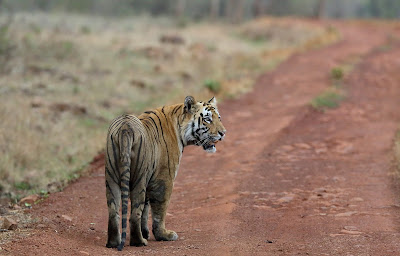My birding trip was on hold for quite sometime. Firstly the place was undecided. A friend of mine suggested Ganeshgudi but getting there from Lucknow seemed tedious ; flight to Goa and then again a 3 hour long drive to the destination from the airport. I wasn't encouraged for the time being and decided to look for some other place.
Lucknow's weather turned murky in the last week of October. A depressive yellow - black smog engulfed the city. I stopped my morning walks but staying confined in the home was another challenge . So I decided a trip to hills with camera.
A call to Rohit Nayal got me going. Rohit runs a birding outfit near Sattal which is famous as Himalaya Birding Tours. His establishment - the Damayanti Hotel and Resort is located near the famous Nal - Damayanti pond on way to Sattal. Rohit informed that the weather there was absolutely pristine and I may come in.
I left Lucknow on 1st November morning and reached Rohit's resort around 5 in the evening after an eight and half hours drive. I took an early dinner and decided to catch some sleep in order to be ready with the next day's schedule which was to begin early from 6 o'clock in the morning.
Met Rohit in the morning over tea while he was preparing to leave for Chopta along with a party of 3 birders. Rohit owns a set up there also . His younger brother Sandeep was to be my guide for my entire birding trip.
Sandeep took me to the nearby Christian Ashram where he had build a bird hide which is now owned by the Ashram. This place is surrounded by a verdant virgin forest and an excellent place for watching birds. The bird platform is about 20 feet distant from the hide chairs ; an ideal distance for super - tele lenses up to 500 mm and shows that it has been built keeping photography needs in mind. However it is good to take another standby camera with a 70-300mm zoom lens in order to cover close group shots which otherwise may not be possible with a tele lens.
Sandeep requested the caretaker to place the feed and then the magic began. The first to arrive were the White Crested Laughingthruhes followed by White Chested Laughingthrushes. They came in flocks. They departed after 5-7 minutes and then entered the Red Jungle Fowls and with them the much sought after Khaleej Pheasants.
Sunlight had started streaking in by this time and with that flew in the Greater Barbet
and the Scaly-bellied Woodpeckers. It was such a wonderful sight that after sometime I put down my camera and started enjoying the surreal drama being played before my eyes by a myriad of stunningly beautiful winged creatures.
In search of Black Partridge, Red - billed Leiothrix , trip to Chafi and Pangot. Read in Part II.
Lucknow's weather turned murky in the last week of October. A depressive yellow - black smog engulfed the city. I stopped my morning walks but staying confined in the home was another challenge . So I decided a trip to hills with camera.
A call to Rohit Nayal got me going. Rohit runs a birding outfit near Sattal which is famous as Himalaya Birding Tours. His establishment - the Damayanti Hotel and Resort is located near the famous Nal - Damayanti pond on way to Sattal. Rohit informed that the weather there was absolutely pristine and I may come in.
I left Lucknow on 1st November morning and reached Rohit's resort around 5 in the evening after an eight and half hours drive. I took an early dinner and decided to catch some sleep in order to be ready with the next day's schedule which was to begin early from 6 o'clock in the morning.
Met Rohit in the morning over tea while he was preparing to leave for Chopta along with a party of 3 birders. Rohit owns a set up there also . His younger brother Sandeep was to be my guide for my entire birding trip.
Sandeep took me to the nearby Christian Ashram where he had build a bird hide which is now owned by the Ashram. This place is surrounded by a verdant virgin forest and an excellent place for watching birds. The bird platform is about 20 feet distant from the hide chairs ; an ideal distance for super - tele lenses up to 500 mm and shows that it has been built keeping photography needs in mind. However it is good to take another standby camera with a 70-300mm zoom lens in order to cover close group shots which otherwise may not be possible with a tele lens.
Sandeep requested the caretaker to place the feed and then the magic began. The first to arrive were the White Crested Laughingthruhes followed by White Chested Laughingthrushes. They came in flocks. They departed after 5-7 minutes and then entered the Red Jungle Fowls and with them the much sought after Khaleej Pheasants.
Sunlight had started streaking in by this time and with that flew in the Greater Barbet
and the Scaly-bellied Woodpeckers. It was such a wonderful sight that after sometime I put down my camera and started enjoying the surreal drama being played before my eyes by a myriad of stunningly beautiful winged creatures.
In search of Black Partridge, Red - billed Leiothrix , trip to Chafi and Pangot. Read in Part II.
<script async src="https://pagead2.googlesyndication.com/pagead/js/adsbygoogle.js?client=ca-pub-2331515138562989"
crossorigin="anonymous"></script>

















































